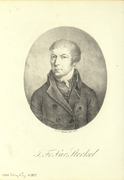Sterkel 200
Dr. Joachim Fischer
Thursday, October 12, 2017

The following is a guest post by Dr. Joachim Fischer, president of the J. F. X. Sterkel-Gesellschaft e.V. and editor of the Sterkel thematic catalog: Johann Franz Xaver Sterkel (1750-1817). Thematisch-bibliographisches Werkverzeichnis (StWV), Neustadt an der Aisch: Sterkel Gesellschaft, 2014.
Composer Johann Franz Xaver Sterkel, who died on 12 October 1817, was acquainted with Mozart and Beethoven but never matched their long-lasting fame. At the same time, he left behind a vast oeuvre with over 700 compositions. Aschaffenburg was one of the places where he was active, and for this reason the theater there will present the German premiere of his only opera, Il Farnace, from 3 to 5 November 2017.
Johann Franz Xaver Sterkel was born on 3 December 1750 in Würzburg. After training for the clergy, he was hired as organist for Stift Neumünster. His first compositions date from around 1774. Giovanni Punto brought Sterkel’s eight symphonies, op. 7 and op. 11, to Paris, where they enjoyed great success from 1777 to 1782 with 52 performances as part of the concert series Concert Spirituel.
In 1777, Sterkel caught the attention of the Mainz state minister Wilhelm Friedrich Graf von Sickingen and invited him to Aschaffenburg. Prince-bishop Joseph von Erthal of Mainz invited Sterkel to his court as Hofklaviermeister in 1778. At the end of 1779, he sent him with his half-brother Franz Lehritter to Italy for further studies. The queen of Naples commissioned an opera from Sterkel for Carnival. Il Farnace was premiered on 12 January 1782 at the Theater San Carlo to celebrate the king’s birthday.
By 1787, 28 of Sterkel’s works had appeared in print. On 3 September 1791, the court chapel in Bonn, including a 21-year-old Ludwig van Beethoven, visited the famous Sterkel in Aschaffenburg, who impressed his audience with his “very light and highly pleasing” piano playing.
In 1793, the elector named Sterkel to the position of court music director and Kapellmeister. His two large-scale symphonies op. 35 in D and B-flat were composed during a time that saw a brief flourishing of court music. How these magnificent works ended up in the United States is still to be researched, but they were each performed five times by musicians of the Moravian community in Nazareth, Pennsylvania between 1796 and 1804!
Sterkel’s compositions beginning in 1797 in Würzburg include four masses. From 1802, he experienced a very creative and productive compositional phase in Regensburg.
On 23 August 1810, Sterkel assumed leadership of court music in Aschaffenburg and saw through the founding of the music school as artistic supervisor and professional advisor.
Aschaffenburg became Bavarian in 1814. Sterkel remained there, composed, and taught voice students, but on 1 September 1817 he returned to his hometown of Würzburg and died there on 12 October 1817.
Johann Franz Xaver Sterkel left behind a very comprehensive, rich, and still to a large extent unexplored body of works, including 400 wonderful songs in German and Italian.
The RISM online catalog has 1,148 sources on Johann Franz Xaver Sterkel, including the autograph manuscript to Il Farnace (D-MÜs SANT Hs 4077a.b.c.; RISM ID no. 451018280) and more than 70 links to digitized music.
Image: Johann Franz Xaver Sterkel, lithograph by Heinrich Euard Winter (1788-1829) from 1816. Image from Joachim Fischer’s private collection.
Share Tweet EmailCategory: Musical anniversaries

